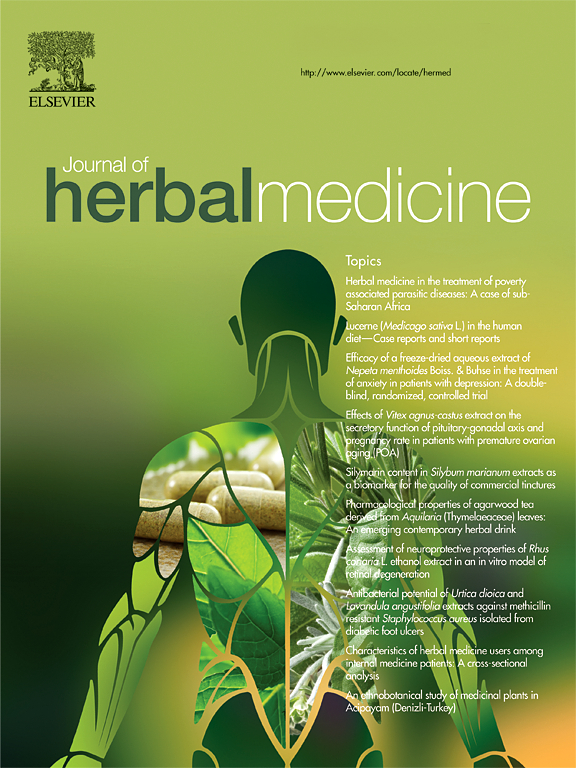Targeting NAFLD and NASH with Tinospora crispa: insights from network pharmacology and molecular dynamics
IF 1.9
4区 医学
Q2 INTEGRATIVE & COMPLEMENTARY MEDICINE
引用次数: 0
Abstract
Introduction
Tinospora crispa (TC), also known as ‘Petawali,’ is an Indian medicinal plant renowned in folk medicine and Ayurveda for its extensive therapeutic properties. Despite its known benefits, the hepatoprotective potential of TC, particularly against Non-Alcoholic Fatty Liver Disease (NAFLD) and Non-Alcoholic Steatohepatitis (NASH), remains unexplored scientifically. This study aims to identify phytocompounds in TC that may be effective against NAFLD/NASH-related targets and elucidate their mechanisms of action.
Method
We utilised fingerprint-based similarity search analyses to predict targets for each phytocompound. Network pharmacology, facilitated by ‘Cytoscape’ and its ‘Cytohubba’ plugins, was employed to establish connections between specific phytocompounds of TC and potential targets of NAFLD. Molecular docking followed by MM/GB(PB)SA scoring analyses were performed with these phytochemicals against a range of crystal structures and homology models of biological target proteins. Around 500 ns molecular dynamics simulations were conducted for the selected biological targets and docked phytoconstituents to understand dynamic behaviours of the complexes.
Result
Molecular docking and MM/GB(PB)SA scoring revealed that 3′-O-methylluteolin, diosmetin, genkwanin, and luteolin may show promising activity whereas molecular dynamics simulation highlighted that 3′-O-methylluteolin might be the most suitable phytochemical for NAFLD treatment.
Conclusion
Overall, these four compounds may modulate key proteins such as CYP3A4, MMP1, PPARδ, PPARγ, AKT1, CYP1A2, and STAT3. This study provides a scientific basis for the potential use of TC in managing NAFLD and NASH, encouraging further research and development in this domain.

用crispa Tinospora靶向NAFLD和NASH:来自网络药理学和分子动力学的见解
tinospora crispa (TC),也被称为“Petawali”,是一种印度药用植物,因其广泛的治疗特性而在民间医学和阿育吠陀中享有盛誉。尽管有已知的益处,但TC的肝保护潜力,特别是对非酒精性脂肪性肝病(NAFLD)和非酒精性脂肪性肝炎(NASH)的保护潜力仍未得到科学探索。本研究旨在鉴定TC中可能对NAFLD/ nash相关靶点有效的植物化合物,并阐明其作用机制。方法采用基于指纹图谱的相似度搜索分析方法预测各植物化合物的靶点。网络药理学,通过‘ Cytoscape ’及其‘ Cytohubba ’插件,建立了TC特定植物化合物与NAFLD潜在靶点之间的联系。对这些植物化学物质进行分子对接,然后进行MM/GB(PB)SA评分分析,与一系列生物靶蛋白的晶体结构和同源性模型进行比较。对选定的生物靶点和对接的植物成分进行了约500 ns的分子动力学模拟,以了解配合物的动力学行为。结果分子对接和MM/GB(PB)SA评分显示,3′- o -甲基木犀草素、洋芋素、根宽素和木犀草素可能具有良好的活性,而分子动力学模拟显示,3′- o -甲基木犀草素可能是治疗NAFLD最合适的植物化学物质。综上所述,这4种化合物可能调控CYP3A4、MMP1、PPARδ、PPARγ、AKT1、CYP1A2和STAT3等关键蛋白。本研究为TC在NAFLD和NASH治疗中的潜在应用提供了科学依据,鼓励了该领域的进一步研究和发展。
本文章由计算机程序翻译,如有差异,请以英文原文为准。
求助全文
约1分钟内获得全文
求助全文
来源期刊

Journal of Herbal Medicine
INTEGRATIVE & COMPLEMENTARY MEDICINE-
CiteScore
3.90
自引率
0.00%
发文量
94
期刊介绍:
The Journal of Herbal Medicine, the official journal of the National Institute of Medical Herbalists, is a peer reviewed journal which aims to serve its readers as an authoritative resource on the profession and practice of herbal medicine. The content areas of the journal reflect the interests of Medical Herbalists and other health professionals interested in the clinical and professional application of botanical medicines. The objective is to strengthen the research and educational base of herbal medicine with research papers in the form of case studies, original research articles and reviews, monographs, clinical trials and relevant in vitro studies. It also publishes policy statements, opinion pieces, book reviews, conference proceedings and profession related information such as pharmacovigilance reports providing an information source for not only the Herbal Practitioner but any Health professional with an interest in phytotherapy.
 求助内容:
求助内容: 应助结果提醒方式:
应助结果提醒方式:


